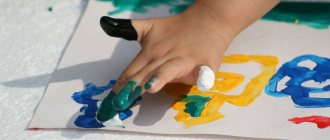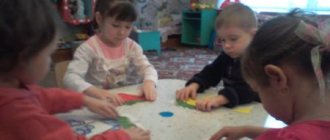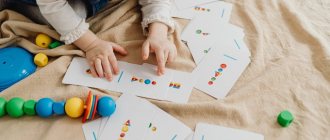Preview:
MUNICIPAL BUDGETARY PRESCHOOL EDUCATIONAL INSTITUTION KINDERGARTEN "GOLDEN COCK"
Summary of GCD in the 2nd junior group on the topic:
Highest qualification category
Summary of GCD on the topic: “Vegetable garden on the window.”
-Teach children to set goals for themselves,
-Prepare the workplace and clean up after yourself;
-Cultivate a desire to achieve results, to participate in a common cause.
Preliminary work: examining the bulb; teacher's story about the medicinal properties of onions.
Materials: bulbs, a box of soil, shovels, watering cans.
Teacher (brings a basket of onions): Children, look, what’s in my hands?
Educator: Do you want to know what’s in my basket? (children's answer). Then guess the riddle: “Grandfather is sitting, dressed in a hundred fur coats, whoever undresses him sheds tears.” (Onion)
Educator: That's right, onion. How many onions do I have in my basket?
Children: There are a lot of onions in the basket.
Educator: That's right, a lot. I'll give the onion to Diana, how many onions does she have now?
Children: One or few.
Educator: What kind of onion am I holding?
Educator: What kind of onion is this?
Educator: Correct, what color is the onion skin?
Educator: What shape is the onion?
Educator: The bow is correctly round in shape. Let's draw a circle in the air with our finger. Well done! Take the onion from my basket and try to roll it on the floor. The bow rolls like a ball. Round bow.
Educator: Shake the onion. What does it feel like?
Educator: Yes, onions help heal people.
Educator: Who wants to treat themselves to onions? (I put a plate on the table with pieces of black bread with green onions on it).
Educator: What do onions taste like?
Educator: Bitter, but very healthy, it contains a lot of vitamins. If we eat onions, it will kill the microbes in our body and we will not get sick.
In the garden in the morning, look at the bed: bending forward and backward
Green onions do exercises in the wind. stretching upward;
Turnips and radishes hardly got up for exercise, walking in place;
There are leaves looking up, raise your hands up, wave
Here - bent low. sit down
Educator: What do you think needs to be done to get green onions? (Showing onion feathers, Children's answers)
Educator: To get such feathers you need to sprout onions.
Practical part: Planting onions
Educator: Do you want green onions to grow in our group? (Children's answers) Let's put him in jail?
In order not to get dirty yourself and not to stain the table, what should you do? (children's answers) That's right, lay the table, put on aprons.
Let us plant our bulbs in the ground. Go to the box with the soil, make a hole in the ground. Find the bottom of the onion. Now plant the bulb so that its upper part protrudes from the ground. You need to plant onions in the ground with the bottom like this (demonstration).
The children take turns planting their own bulbs. (Music “Sounds of Nature” sounds)
Educator: Think about what else needs to be done (children's answers). You need to water the onions correctly from a watering can. Sasha, water the onions. Water carefully, do not pour too much water. Who else will water the onions?
Educator: Now think about what other conditions are necessary for the growth of bulbs? (children's answers) Indeed - light and warmth.
Where will we put the onions so that they grow better for us?
Children: On the windowsill closer to the sun.
Educator: That's right, closer to the sun. Now we will watch our onions grow every day.
Well done guys, everyone did a good job planting the onions, now let’s rest, join the round dance, sing and dance.
Round dance “We’ll go to a round dance”
Here are the cheerful people going to the garden. We need to plant an onion and surprise everyone in the area (children walk in a circle). We’ll take a shovel and start digging up the beds. We dig together and plant onions. (digging the ground with a shovel)
We didn’t have time to plant it, we need to water the onion (the children plant the onion) We took the watering can in our hands, watered the onion (water it) The sun bakes our onion and warms it up (the children raise their hands up and swing)
The onion will grow big, (point to the onion, raise their hands from bottom to top) You and I will eat (pat ourselves on the tummy)
Source
Junior group. Early childhood, nursery. Children 1-4 years old
Poster "Take care of nature." Collaborative activities between teachers and young children
Poster "Take care of nature "
. Joint activities of a teacher with young children. From an early age, children need to be instilled with the concept that the planet is our common home, we need to take care of it, protect it with all our might: we need to protect the air we breathe, we need to save the water that...
Summary of the lesson on ecology “Take care of nature” (second junior group) In MBDOU 288, group 5, environmental lessons were held as part of the All-Russian campaign “ Ecolyats - Young Nature Defenders ”. While working with children, we touched on the topic “Take care of nature ,” formed a responsible attitude towards nature , increased the level of environmental ...
Progress of the lesson:
Educator: Guys, look what I brought you, these are onions, carrots, garlic, potatoes, tomatoes, cucumbers, cabbage, beets. Now you and I will play and we will all turn into “vegetables”
. The teacher says the child's name and what vegetable he receives.
Invites the children to name who they have turned into.
Educator: Well, everything is ready, and we are going to our garden . And here is our magical garden bed. Look at it, how many vegetables there are! Now we’ll go up to it and pick the green onions. Who is our bow?
It turns out that a child with a bow in his hands comes forward.
grow in the ground , they are bitter, when they peel them and cut them with a knife, tears flow from the eyes and green arrows grow . These are onion feathers, they are eaten, cut into salads and soups. Let's rub our eyes with our fists, wave our palms at them, and don't let our eyes cry! In order not to get sick, not to be afraid of colds - you need to stock up on onions for the winter!
Educator: What kind of vegetable is this?
Educator: That's right, it's a carrot! Where is our carrot?
It turns out that a child with a carrot in his hands comes forward.
Educator: Carrots grow , and you need to work hard to get them out of there. Carrots are orange in color, tasty, sweet and contain a lot of vitamins. Carrots also have a fluffy tail (tops)
Green colour.
When the wind blows, the carrot's tail sways in different directions. Let's raise our hands up, spread (like tops), and sway left and right. Well done!
Educator: Well, who's our garlic? Come out.
It turns out that a child with garlic in his hands comes forward.
You can rub the crust of black bread with garlic - it turns out very tasty, and you can also cut it into soup. Garlic is a very healthy vegetable; it helps against many diseases - both colds and runny nose. Its leaves are long, narrow and green, and the garlic itself is white, like its clove itself!
Educator: Now let’s do the exercise: open your mouth, show your teeth, close it, and again. And now they raised their hands up and circled in one direction, and then in the other. Well done guys!
Educator: Who is our potato? Come here.
It turns out that a child with a potato in his hands comes forward.
Educator: Potatoes grow in the ground , they boil them, fry them, they are very tasty. It is large, round, the peel is similar in color to the ground. Let's pretend to be a potato: put your hands on your belt, and we walk, swaying from foot to foot. Educator: Who is our beet? Come forward.
It turns out that a child with beets in his hands comes forward.
Educator: Beets are red, round, tasty and sweet, and the leaves of beets have long stalks, greenish on one side and reddish on the other.
Educator: Where is our cabbage, come forward.
It turns out that a child with cabbage in his hands comes forward.
Educator: Cabbage is green, crispy, it has many, many leaves, and inside it has a sweet stalk. Everyone loves cabbage, both children and adults.
Educator: Where is our tomato? Come forward.
It turns out that there is a child with a tomato in his hands.
Educator: Tomatoes grow on a bush , at first they are small and green, and then they grow and grow , gradually turning red, becoming red, sweet and tasty.
Educator: Who is our cucumber? Come out, don't be shy forward.
It turns out that a child with a cucumber in his hands comes forward.
Educator: The cucumber is green, long, sweet, crispy! It's oval shaped!
Educator: Guys, vegetables have roots; vegetables “drink”
water, and if the roots are torn off,
the plant will die and wither!
Now tell me, please, for vegetables to grow what they need? Educator: So the journey to our magical garden has ended. Did you like it? We learned a lot of good things about vegetables. Well done guys, they worked well and answered my questions correctly.
Ecological educational and research project “A miracle garden grows on a window” in the senior group Implementation period: January 10 – February 28, 2021. Project duration: short-term. Project participants: senior children, teachers.
Conversation in the second junior group “No one is forgotten, nothing is forgotten” On the eve of the Victory Day celebrations, we are holding an introductory event with the kids so that in the future they will have an idea of what is significant. Photo report “We planted a vegetable garden, look what’s growing!” Dear colleagues! I bring to your attention a photo report about our small vegetable garden on the window. Our cheerful garden is thriving and alive. Come in. Photo report “Our favorite vegetable garden, what doesn’t grow in it” Goal: to form children’s ecological ideas about vegetables and garden crops in the process of growing from seeds indoors; Photo report “We planted a vegetable garden and let’s see what grows!” (second junior group) Hello, dear colleagues! Every year, traditionally at the end of February, planting onion seeds and vegetables begins in our kindergarten.
Research project “Planted a vegetable garden - see what’s growing” Introduction Once on a walk, the children and I watched how adults prepared vegetable gardens for planting, planted and sowed the first seeds. And I saw, s.
Project “A miracle garden grows on the window” (senior preschool age) Project participants: older children, parents, teachers. Equipment and materials: containers and soil for planting, vegetable seeds.
Project “A miracle garden is growing on a windowsill” The influence of the surrounding world on a child’s development is enormous. Many parents do not even suspect that the green kingdom will begin to cause a huge one.
Entertainment: “Here is a cheerful garden, what doesn’t grow here” Entertainment: “Here is a cheerful garden, what doesn’t grow here” in the senior group The purpose of the entertainment is to show the importance of vegetable crops for. Environmental project in kindergarten “Let’s sow a garden together and see what grows!” Video Ecological project “Together we will sow a garden and see what grows” Description of the project: The presence of a vegetable garden in a kindergarten contributes to the implementation.
Source
Progress of the lesson:
Hello guys. Let's take a trip through our magical garden and see what grows in it.
A psychologist invites children to play the game “What grows in the garden ?”
He asks a riddle, and the children find the answer to the picture.
Without windows, without doors, full of people (cucumber)
A hundred clothes and all without fasteners (cabbage)
A girl is sitting in a dungeon, and her scythe is on the street (carrot)
Grandfather is sitting, dressed in a hundred fur coats (bow)
Well done kids, now tell me, how can we call all these objects in one word? correct (vegetables)
. Why do we need vegetables? A person should eat a lot of vegetables because they contain many essential vitamins.
You guys learned a lot today, how our vegetables grow, well done, you answered all my questions.
“Vegetable garden on the windowsill” is an experimental lesson on ecology in the second junior group. Goal: to expand children’s understanding of onions, parsley, dill, their properties, beneficial qualities, and growing technology. Material: seeds. “Do-it-yourself vegetable garden” Ecological activity in the second junior group. Goal: to familiarize children with the process of planting seeds, the development of fine motor skills, accuracy, observation, attention, and arouse desire. Photo report of the “Vegetable Garden on the Windowsill” project in the second junior group I would like to share with you the work of the “Vegetable Garden on the Windowsill” project. Why did I choose this particular topic? Well, first of all, it’s the most useful thing in winter.
Abstract of the educational activity “Spring garden” with children of the second junior group. Developed in accordance with the thematic week “World Spring and Labor Week”. Goal: Expand the understanding of vegetables and their characteristics.
Summary of a training session on speech development in the second junior group Topic: Conversation “When does this happen?” Goals: Formation of skills to conduct a group conversation. Objectives: Educational: To consolidate knowledge about the seasons and their characteristic features. Educational:.
Project “A miracle garden grows on the window” in the second junior group Project participants: young children, parents, teachers. Equipment and materials: boxes with soil, plant seeds, watering cans, scoops.
Project “Our garden on the window” in the second junior group Relevance of the project: tell children what benefits onions bring, that they contain a lot of vitamins. You need to eat onions to avoid getting sick. Show. Project “Garden of Gnomes” in the second junior “B” group 1. Type of project: creative, research, group. 2. Author of the project: teacher Fritzler O. f. 3. Project duration: short-term.
Project “Vegetable garden on the windowsill” for children of the second junior group Short-term educational and research project “Our cheerful vegetable garden” Second junior group Implementation period: (from February 17 to April 19.
Source



